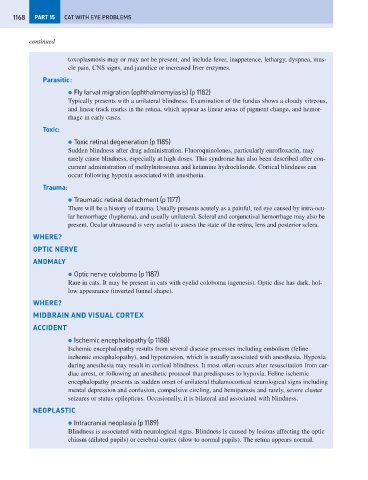Page 1176 - Problem-Based Feline Medicine
P. 1176
1168 PART 15 CAT WITH EYE PROBLEMS
continued
toxoplasmosis may or may not be present, and include fever, inappetence, lethargy, dyspnea, mus-
cle pain, CNS signs, and jaundice or increased liver enzymes.
Parasitic:
● Fly larval migration (ophthalmomyiasis) (p 1182)
Typically presents with a unilateral blindness. Examination of the fundus shows a cloudy vitreous,
and linear track marks in the retina, which appear as linear areas of pigment change, and hemor-
rhage in early cases.
Toxic:
● Toxic retinal degeneration (p 1185)
Sudden blindness after drug administration. Fluoroquinolones, particularly enrofloxacin, may
rarely cause blindness, especially at high doses. This syndrome has also been described after con-
current administration of methylnitrosurea and ketamine hydrochloride. Cortical blindness can
occur following hypoxia associated with anesthesia.
Trauma:
● Traumatic retinal detachment (p 1177)
There will be a history of trauma. Usually presents acutely as a painful, red eye caused by intra-ocu-
lar hemorrhage (hyphema), and usually unilateral. Scleral and conjunctival hemorrhage may also be
present. Ocular ultrasound is very useful to assess the state of the retina, lens and posterior sclera.
WHERE?
OPTIC NERVE
ANOMALY
● Optic nerve coloboma (p 1187)
Rare in cats. It may be present in cats with eyelid coloboma (agenesis). Optic disc has dark, hol-
low appearance (inverted funnel shape).
WHERE?
MIDBRAIN AND VISUAL CORTEX
ACCIDENT
● Ischemic encephalopathy (p 1188)
Ischemic encephalopathy results from several disease processes including embolism (feline
ischemic encephalopathy), and hypotension, which is usually associated with anesthesia. Hypoxia
during anesthesia may result in cortical blindness. It most often occurs after resuscitation from car-
diac arrest, or following an anesthetic protocol that predisposes to hypoxia. Feline ischemic
encephalopathy presents as sudden onset of unilateral thalamocortical neurological signs including
mental depression and confusion, compulsive circling, and hemiparesis and rarely, severe cluster
seizures or status epilepticus. Occasionally, it is bilateral and associated with blindness.
NEOPLASTIC
● Intracranial neoplasia (p 1189)
Blindness is associated with neurological signs. Blindness is caused by lesions affecting the optic
chiasm (dilated pupils) or cerebral cortex (slow to normal pupils). The retina appears normal.

